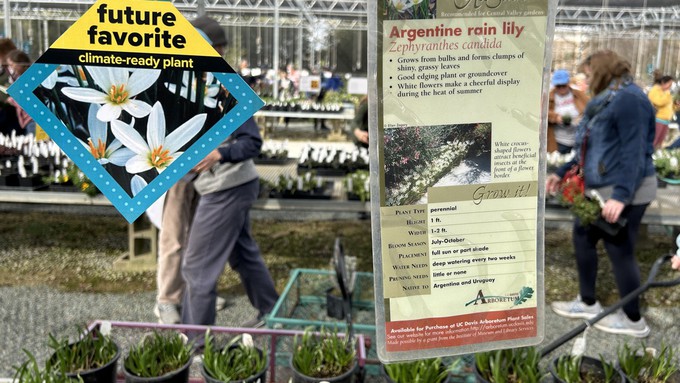
Event features succulents, natives and water-wise perennials; members get in early

Some of the plants sold at the UC Davis Arboretum Nursery carry signs designating them as "future favorites," or plants adaptable to the changing climate. These include Argentine rain lilies. Kathy Morrison
Find hundreds (make that thousands) of possibilities at the UC Davis Arboretum’s Teaching Nursery.
This Sunday, April 7, the arboretum’s 1-acre nursery will host its first public sale of the season. From 10 a.m. to 1 p.m., the sale will be open to everyone. Admission is free.
Want an early start on plant shopping? From 9 to 10 a.m., members of Friends of the Arboretum get first crack Sunday. Not a member? Join at the gate, get at 10% discount and a $10 coupon for the sale.
April is a wonderful time to add water-wise perennials, shrubs, trees and native plants to our landscapes. The weather is warming and so is the soil, which is moist and soft due to recent rain.
Two more sales are scheduled after Sunday: A split sale April 27 and the season-ending spring clearance May 11.
Now available online, the updated inventory list covers 53 pages from four varieties of Abutilon (flowering maple) to three species of Zephyranthes (Argentine rain or zephyr lily). Find it here: https://ucdavis.app.box.com/s/cqttqucpsq1oresaluj2zyz1cpwkf5uf
Also useful is an accompanying photo gallery with hundreds of shots of featured plants. It helps visualize how the baby plants in their 4-inch or 1-gallon pots will look like when fully grown. (Sometimes, that’s much, much bigger.) Atop the gallery are several varieties of mangave, a succulent hybrid of agave and manfreda that’s a favorite for water-wise landscaping.
See the gallery here: https://airtable.com/appGYzBN8THFEAEsX/shrN3Jyghg4NNcK7L/tbl2CPT7gEomY1f0S
Take it from our experience: Research plants before you shop, and compile a list with the plant locations in the nursery. Bring a wagon or rolling cart if you have one. Often early in the sale, there’s a waiting list for the nursery wagons.
The Arboretum Teaching Nursery is located at 1046 Garrod Drive, Davis, on the UC Davis campus near the small-animal veterinary hospital. Parking is available in the adjoining lots. Student volunteers stationed on corners can direct visitors to parking areas.
Details and directions: https://arboretum.ucdavis.edu/.
Comments
0 comments have been posted.Sacramento Digs Gardening to your inbox.
Sites We Like
Garden Checklist for week of May 5
Survey your garden after the May 4 rainstorm. Heavy rain and gusty winds can break the neck of large flowers such as roses. Also:
* Keep an eye on new transplants or seedlings; they could take a pounding from the rain.
* Watch out for powdery mildew. Warmth following moist conditions can cause this fungal disease to “bloom,” too. If you see a leaf that looks like it’s dusted with powdered sugar, snip it off.
* After the storm, start setting out tomato transplants, but wait on the peppers and eggplants (they want warmer nights). Pinch off any flowers on new transplants to make them concentrate on establishing roots instead of setting premature fruit.
* Trim dead flowers but not leaves from spring-flowering bulbs such as daffodils and tulips. Those leaves gather energy to create next year's flowers. Also, give the bulbs a fertilizer boost after bloom.
* Pinch chrysanthemums back to 12 inches for fall flowers. Cut old stems to the ground.
* Mulch around plants to conserve moisture and control weeds.
* From seed, plant beans, beets, cantaloupes, carrots, corn, cucumbers, melons, pumpkins, radishes and squash.
* Plant onion sets.
* In the flower garden, plant seeds for asters, cosmos, celosia, marigolds, salvia, sunflowers and zinnias. Transplant petunias, zinnias, geraniums and other summer bloomers.
* Plant perennials and dahlia tubers for summer bloom.
* Don’t wait; plant summer bulbs, such as gladiolus and tuberous begonias.
* Harvest cabbage, lettuce, peas and green onions.